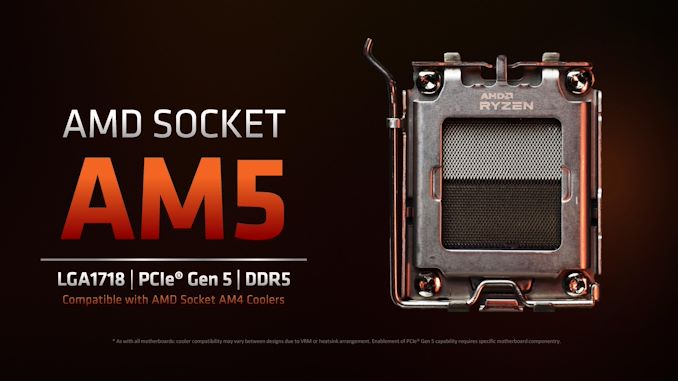CES 2022: AMD’s Next-Gen AM5 Platform to Have Long Term Support
by Dr. Ian Cutress on January 7, 2022 9:00 AM EST- Posted in
- CPUs
- AMD
- Trade Shows
- AM4
- Lisa Su
- Zen 4
- CES 2022
- AM5
- Ryzen 7000

One of the key aspects of AMD’s offering in the consumer desktop space is the longevity of its socket and platform. Throughout the years, AMD has leveraged a single socket for multiple generations, providing users the ability to keep the same motherboard year in and year out, while the competition changes the socket every couple of generations at best. To keep that mantra, AMD has stated that its next-generation platform coming later this year, AM5, will also be a multi-generational platform.
Going back in AMD’s history we can see just how long various platforms have lasted, from first processor launch to last processor launch:
- Socket 939 from 2004 to 2006
- AM2/2+ socket from 2006 to 2009
- AM3/3+ socket from 2009 to 2013
- FM2/2+ socket from 2012 to 2015
- AM4 socket from 2016 to 2021
- AM5 socket from 2021 to ...
Within that time there have been chipset updates to allow for better IO, however usually the socket change has happened because of DDR version changes, interconnect, and PCIe. In this instance, the move from AM4 to AM5 comes with a change from DDR4 to DDR5 and PCIe 4.0 to PCIe 5.0.
In a roundtable with Dr. Lisa Su, the question was asked about how long AM5 would be around – now that AMD has a sustainable position again in the desktop, and by many measures a leading position, would AMD continue its tradition of longer-lived desktop platforms. Dr. Su stated that AM4 ‘has been good for the community and … it’s been good for us as well’. She confirmed that a change was required with the new standards, but on strategy it was put that ‘I don’t have an exact number of years but I would say that you should expect that AM5 will be a long-lived platform as AM4 has been’. Dr. Su also stated that even with the introduction of AM5, the company expects AM4 to stay in the marketplace for some years, with overlap between the two depending on the market.
For users wondering how far AM5 can go before it needs to change again, it’s worth looking at roadmaps for the two usual elements that cause socket updates: memory and PCIe. We’re only just on the transition to DDR5, and DDR6 is a long way away – in a recent Samsung presentation, for example, it listed DDR6 as a 2028 technology. Similarly with PCIe 5.0, the same presentation puts PCIe 6.0 as a 2026 technology, and PCIe 7.0 as a 2029 technology. So unless AMD wants to increase the pin count on the CPUs for more memory channels or more PCIe lanes, the PCIe 5.0+DDR5 combination looks set until at least 2026.











42 Comments
View All Comments
NickConrad - Friday, January 7, 2022 - link
I guess I'm in the vast minority, but if I'm upgrading my CPU there's no way I'm not upgrading everything. A multi-generation socket hardly even warrants a shrug from a customer like me.Makaveli - Friday, January 7, 2022 - link
i'm the opposite why do a full system rebuild when you don't have to. AM4 has allowed me to go Zen 2 to Zen 3 without changing anything else. And i'm not someone that does new builds every 2 years so works for me.DanNeely - Friday, January 7, 2022 - link
I go long enough between CPU updates that even AMD's longer lived sockets have been gone before I saw enough increased performance to justify them. S939 (2005) to LGA-1366 (2009), to LGA1150 (2015).My next system will probably be late 2022/early 2023. If I go AMD near the end of AM5 might have enough gains to justify an upgrade to me again; but if so unless it's a critical need I'll probably wait for AM6 (or go Intel) because I don't want to miss out on whatever other new shinies have been added in the interim for anther half dozen years.
thestryker - Friday, January 7, 2022 - link
This is the same boat I'm in (went from 939 to 1366 to 2011) where I don't upgrade often enough to particularly care about long term support. I care much more about future proofing the platform I get as much as possible than the ability to pop a new CPU in.Qasar - Friday, January 7, 2022 - link
keep on mind though, for the most part, intels cpus werent worth the upgrade gen on gen. most would skip 2 or 3 gens before upgrading. where with zen, it was worth the upgrade. i went from a 3900x to a 5900x and the increase i saw was quite noticable, specially with handbrake and video editing.drothgery - Friday, January 7, 2022 - link
No, you're in the vast majority (because most people by pre-built systems, usually laptops, and even enthusiasts who build everything themselves rarely upgrade CPUs without getting a whole new motherboard because usually enough has come out since you did that to justify it even if there's not a socket change or other incompatibility even if you're not flipping from AMD to Intel or vis versa).Jp7188 - Friday, January 7, 2022 - link
I could go the other direction entirely. My 6700k was great, but I wanted faster storage, USB, and Ethernet. A new platform was a bigger decider than faster CPU.meacupla - Saturday, January 8, 2022 - link
I am totally looking forward to upgrading my 2700X to a 5600X, 5800X or 5800X3D, when the prices come down.Also, there is still a point to having an upgradable CPU, like when you get a free PC, and it only has a pentium in it, but the mobo supports i7. The unfortunate part is, buying an i7 for older sockets is still absurdly expensive on the used market, and I have to buy the correct one, otherwise it doesn't fit.
GeoffreyA - Monday, January 10, 2022 - link
I'd like to upgrade my 2200G to something like the 5600G, but wonder if I'll ever do it before going to a new computer because, except for encoding, it's quite all right.t.s - Wednesday, January 12, 2022 - link
Yep. ~$168 i6 6700K vs ~$140 15 8500 make me laugh. But understandable, cause for Joe and Jill, i7 is always better than i5.